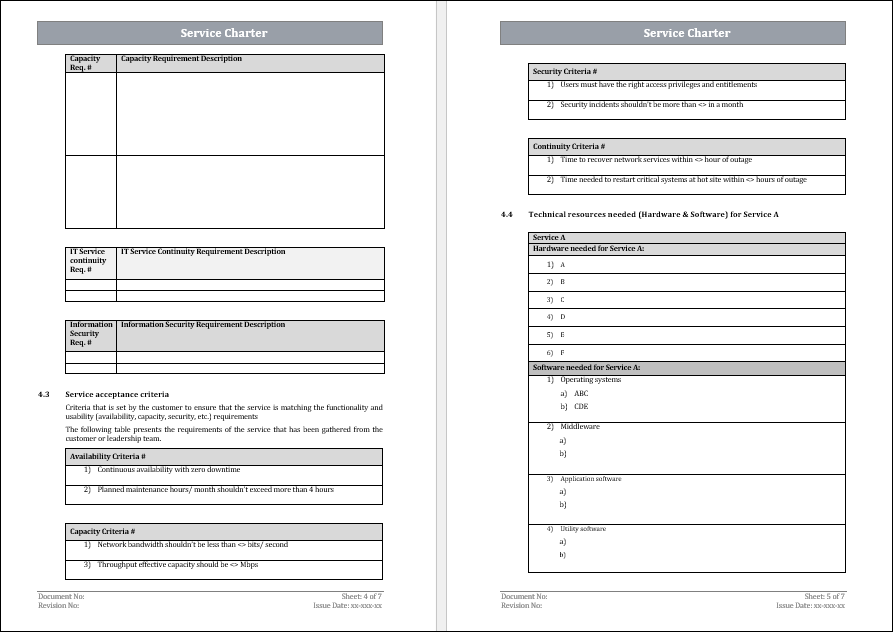Service Charter Template
Introduction
A Service Charter Template in IT Governance is a structured document that defines the core components, aims, and parameters of an organization's IT services. It provides a complete overview of the scope, service levels, roles, responsibilities, and communication plans for IT service delivery. This template establishes a standardised structure for aligning IT services with organisational goals while promoting transparency, accountability, and effective communication. The Service Charter Template helps to ensure the smooth operation, management, and control of IT services by outlining clear expectations and norms, ultimately contributing to the overall success of an organization's IT strategy.

Importance Of A Service Charter Template
The Service Charter Template is a cornerstone in the field of IT Governance, providing a structured framework for orchestrating the smooth delivery and control of IT services inside an organisation. One of its key strengths is the establishment of clarity and transparency. By clearly defining the scope of IT services and outlining critical parameters, the template guarantees that all stakeholders, including internal teams and external users, have a common understanding of the services provided.
Furthermore, the Service Charter Template is an effective instrument for ensuring accountability and responsibility. By defining clear roles and duties for individuals and teams involved in IT service delivery, an organised and accountable environment is established. As a result, the organization's ability to successfully manage and administer IT services improves, establishing an ownership and reliability culture.
Steps For Implementing The Service Charter Template
Step 1: Engage Stakeholders
- Identify and involve important stakeholders, such as IT teams, business units, and top management.
- Collaborate with stakeholders to acquire feedback, insights, and expectations for IT services.
Step 2: Draft the Service Charter
- Use the Service Charter Template to capture critical information such as service scope, objectives, service level agreements (SLAs), roles, duties, and communication strategies.
- Tailor the template to the organization's specific needs and quirks.
Step 3: Customization and Tailoring
- Customise the template to meet the unique needs of the organisation, ensuring that it reflects the specific services, goals, and structures in place.
- Consider stakeholder comments and make appropriate revisions to improve the template's relevance.
Step 4: Review and Approval
- Conduct a thorough review of the draft Service Charter with key stakeholders, gathering input and addressing any issues or ideas.
- Obtain formal permissions from necessary authorities, ensuring that all stakeholders understand and agree with the Service Charter's provisions.
Step 5: Communication Plan
- Create a comprehensive communication plan outlining how the Service Charter will be delivered to all relevant parties.
- Ensure that communication routes are developed and that the content is available to all participants.
Step 6: Training and Awareness
- Provide training sessions or awareness programmes to help teams understand the Service Charter's contents and significance.
- Develop a clear knowledge of roles, duties, and the Service Charter's impact on everyday operations.
Step 7: Implementation Monitoring
- Monitor the Service Charter's implementation to ensure that the set guidelines and objectives are met.
- Set up regular checkpoints to review progress and address any issues that may develop during the early stages of deployment.

Benefits Of Service Charter Template
1. Clarity and Definition of Services: The template precisely outlines the scope of IT services, ensuring that all stakeholders understand exactly what is and is not included.
2. Enhanced Communication and Collaboration: The template includes communication plans, which set procedures for internal and external communication.
3. Accountability and Responsibility: Clearly defines the roles and duties of individuals and teams involved in IT service delivery. This promotes responsibility and ensures that everyone understands their individual roles within the larger service structure.
4. Quality of Service Improvement: The template addresses incident and problem management procedures, establishing defined methods for handling and resolving concerns in a timely manner. This helps to improved service quality and less disruptions.
5. Customer Satisfaction: The template establishes Service Level Agreements, which set expectations for response and resolution timeframes, thereby contributing to high levels of customer satisfaction through timely and effective service delivery.
6. Risk Mitigation: Including change management practices helps to reduce the risks involved with executing changes to IT services by ensuring that adjustments are carefully planned and carried out.
7. Compliance and Governance: Assists organisations in meeting regulatory obligations by documenting processes and procedures and ensuring that IT services are compliant with applicable laws and regulations.
Conclusion
The Service Charter Template is a critical component of IT governance, offering a structured roadmap for the efficient delivery and control of IT services inside an organisation. Its multifarious benefits go beyond simple documentation, providing a foundation for clarity, communication, and accountability. The Service Charter Template ensures that all stakeholders have a single vision by defining the scope of IT services, specifying roles and duties, and developing clear communication plans..

